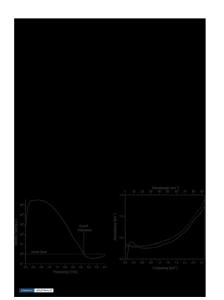Deposition and Characterization of Y 3 Al 5 O 12 (YAG) Films and Powders by Plasma Spray Synthesis
- PDF / 1,066,279 Bytes
- 6 Pages / 612 x 792 pts (letter) Page_size
- 59 Downloads / 355 Views
Deposition and Characterization of Y3Al5O12 (YAG) Films and Powders by Plasma Spray Synthesis Sujatha D. Parukuttyamma1, Joshua Margolis1, Haiming Liu2, John B. Parise1, 2, 3 Clare P. Grey 1, 2, Sanjay Sampath1, Perina Gouma1 and Herbert Herman1 1 Center for Thermal Spray Research, Department of Materials Science and Engineering 2 Department of Chemistry, 3Department of Geosciences, State University of New York at Stony Brook, Stony Brook, New York 11794-2275, U. S. A. ABSTRACT YAG powders and coatings were developed for the first time by a novel precursor plasma spraying technique using the radio frequency (RF) induction plasma technique. The XRD of the as -sprayed coating confirms the presence of YAG, H-YAP or O-YAP or a mixture of the above depending on the spray conditions. 27Al MAS NMR of the YAG coating corroborates the x-ray results. TEM studies on the coatings confirm that the coating consists of nano-structured particles. The successful spraying of these complex oxide coatings proves that chemistry of phase formation can be controlled in the plasma, thus opening up new avenues in material synthesis. INTRODUCTION Plasma or thermal spraying of metals, ceramics and composites is a well established technology for the deposition of coatings on various substrates. In general, the traditional plasma processes utilize powder feedstocks of pre-mixed compositions to develop fine-grained deposit [1]. More recently, thermal spraying of liquid feedstocks is emerging as a viable method for the production of ceramic coatings and powders. A suspension plasma spraying (SPS) technique was reported for the production of ceramic oxides, bioceramics such as hydroxy appatite and also a series of intermetallics from suspensions of the fine powders of the corresponding materials [2]. The Y2O3-Al2O3 phase diagram contains several stable phases including Y3Al5O12, YAG (Yttrium aluminum garnet), YAlO3, O-YAP (Yttrium aluminum perovskite) and Y4Al2O9, YAM (Yttrium aluminum monoclinic) [3]. In addition, a metastable yttrium aluminate phase YAlO3 (H-YAP) crystallizes in the hexagonal form. Among these, the garnet phase possesses extremely high chemical stability, low electrical conductivity and high creep resistance making it useful, for example, as an insulating or refractory coating and as a promising fibre material for ceramic composites. Although synthesis of the cubic garnet phase to form powder is a very sluggish reaction, several liquid phase and soft-chemical routes have been proposed to lower the crystallization temperature of YAG [4-6]. Most of these methods produce only loose powders, which have to be processed further for making refractory coatings or sintered materials. We have been working on developing alumina and doped alumina coatings by employing a modified version of the suspension plasma spraying where a precursor of the material is used as a liquid feed stock [7]. As an extension of this work, attempts were made to develop yttrium aluminum garnet (YAG) from sol and solution precursors considering it as a representat
Data Loading...











